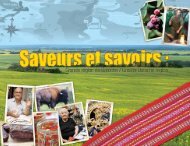Revue Saveurs et savoirs - Partie 2 (.pdf) - Assemblée ...
Revue Saveurs et savoirs - Partie 2 (.pdf) - Assemblée ...
Revue Saveurs et savoirs - Partie 2 (.pdf) - Assemblée ...
You also want an ePaper? Increase the reach of your titles
YUMPU automatically turns print PDFs into web optimized ePapers that Google loves.
Wild Berries<br />
and their Processing<br />
Wild Berries<br />
Wild berries such as saskatoons, chokecherries<br />
and high-bush cranberries are traditionally<br />
eaten by everyone in the area. In the past,<br />
First Nations peoples would dry them or store<br />
them in water or oil to be eaten out of season.<br />
Francophones and Métis also enjoy these<br />
berries and have always eaten them. They<br />
used them to make desserts, preserves, juices<br />
and wines.<br />
The flavour of wild berries is often preferable to<br />
that of commercial berries and because they are<br />
rich in vitamins and minerals, they play an<br />
essential nutritional role.<br />
* Chokecherries<br />
The fruit of the chokecherry (Prunus<br />
virginiana, rose or Rosaceae family) grows<br />
on a shrub that is common throughout<br />
southern Canada and as far north as the<br />
Yukon. Ripening in mid-August, the berries<br />
grow in long clusters and range in colour<br />
from red to black. They have large stony seeds<br />
and can be bitter, but are excellent in jelly,<br />
juice or syrup.<br />
* Saskatoons<br />
The saskatoon berry (Amelanchier alnifolia, rose<br />
or Rosaceae family) grows on a deciduous shrub<br />
found from western Ontario to British Columbia<br />
as well as the Yukon. The city of Saskatoon takes<br />
its name from the Cree word signifying a plump<br />
swe<strong>et</strong> berry that was of key importance to First<br />
Nations peoples and early s<strong>et</strong>tlers. On the<br />
Prairies, saskatoons were an important<br />
ingredient in pemmican. They are still much<br />
appreciated and breeders are developing<br />
numerous vari<strong>et</strong>ies for commercial production.<br />
Some fifteen related species, all with edible fruit,<br />
grow in Canada.<br />
* High-bush cranberries<br />
The high-bush cranberry (Viburnum opulus and<br />
V. edule, honeysuckle or Caprifoliaceae family) is<br />
one of the species of cranberry that produces<br />
red berries. It has an acrid flavour and grows in<br />
bunches on large shrubs. Its flavour pairs well<br />
with meat and game. The high-bush cranberry<br />
has the distinction of giving off a very unpleasant<br />
odour while cooking which some people mask by<br />
adding, before or during the process, citrus zest<br />
and/or juice.<br />
Saskatoons<br />
37




